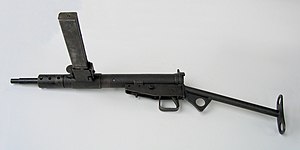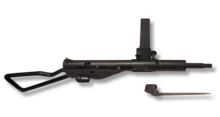Sten Gun
| Sten Gun | |
|---|---|

|
|
| general information | |
| Military designation: | Sten Mk I to Mk VI |
| Country of operation: | Great Britain |
| Developer / Manufacturer: | Reginald V. Shepperd, Harold J. Turpin |
| Development year: | 1941 |
| Manufacturer country: | Great Britain |
| Production time: | since 1941 |
| Weapon Category: | Submachine gun |
| Technical specifications | |
| Caliber : | 9 × 19 mm |
| Possible magazine fillings : | 32 cartridges |
| Ammunition supply : | Bar magazine |
| Cadence : | 500-550 rounds / min |
| Visor : | Hole notch and front sight |
| Closure : | Mass closure |
| Charging principle: | Recoil loader |
| Lists on the subject | |
The term Sten Gun was used for a number of very simply constructed, reliable submachine guns used by the British armed forces during World War II . It replaced the Lanchester submachine gun , which was based on the German MP28 II.
history
The staff of the British state arsenal Major Reginald V. Shepperd and Harold J. Turpin developed this weapon in 1941. The name "Sten" is from the first letters of the last name of the developer Major Reginald V. S hepherd and Harold T Urpin and the initials of the production site EN FIELD composed.
The high material losses during the evacuation of Dunkirk and the vulnerability of American transports by German submarines (→ Atlantic battle ) led to a supply shortage for automatic weapons. Therefore, in June 1941, the simply and roughly manufactured Sten Mk. I was introduced into the British Army .
The Sten proved its worth and was further developed (Sten Mark II, III, IV, V and VI). The simplest version, the Mark III, took five hours to make; the production costs corresponded to one sixth of the Thompson initially used by the US armed forces . The arms factory Royal Small Arms Factory in Enfield produced the first 100,000 pieces of the Sten Mark I (Sten Mk. I, Mk I or Mk 1 for short) by mid-1942 . The last sten in use was the Mk V, with the front sight and bayonet holder of the Enfield No. 4 . This was only followed by the Mk VI with an integrated silencer for special forces. By February 1944, a total of over 4 million stens of all types had been manufactured in Britain.
technology
All Sten submachine guns were self-firing recoilers with an unlocked ground lock . A fire dial allowed single or continuous fire ; the rate of fire was 500 to 550 rounds per minute.
The straight rod magazine held 32 cartridges. The Sten fired the 9-mm-Z-cartridge similar in dimensions to the 9-mm-Para cartridge , this corresponded with a muzzle velocity (v 0 ) of about 420 meters per second (m / s) about the today's NATO-MP -Ammunition. The 9 mm Para cartridge of that time had a v 0 of around 360 m / s. The magazine was of poor quality; bent magazine lips sometimes jammed the load.
A version with a silencer was produced under the name Sten Mark IIS. These weapons had a shorter barrel with pressure relief holes, a lighter breech and a weaker recoil spring. This reduced the v 0 to about 300 m / s and avoided the sonic boom of the projectile. The effective firing range was then a maximum of 100 meters.
use
Captured by Germany in World War II, the Sten Mk I and Mk II were designated as 748 (e) and 749 (e). Initially stamped as "too primitive" and stored, they were given to German troops at the end of 1943 due to the acute lack of weapons. When the advantages of the Sten were recognized in use, replica variants were made: One as the MP 3008 or "Device Neumünster" with ammunition feed from below for the use of MP40 magazines and the other as the "Device Potsdam", which is a detailed copy of the Sten Mark II was.
SOE , the British secret service during World War II, spread the knowledge about the construction of the Sten to resistance groups in several German-occupied countries. Exiles from z. B. Poland and Czechoslovakia worked in Enfield and were possibly smuggled back to their home countries to organize underground workshops. In Poland alone, over 1300 Sten variants were developed and manufactured, and these were used, among other things, in the Warsaw Uprising .
The Sten Gun served in many armies around the world well into the 1960s; the simple construction was also the starting point for other MP constructions ( Carl Gustaf M / 45 , Port Said, Sterling etc.). Among other things, Sten Guns were recreated by both sides before and during the Palestinian War.
literature
- Leroy Thompson: The Sten Gun. Bloomsbury Publishing, 2012, ISBN 978-1-84908-760-5 . (82 pages online PDF)
Web links
Individual evidence
- ↑ a b Leroy Thompson: The Sten Gun. P. 68.
- ↑ a b Reiner Lidschun, Günter Wollert: Encyclopedia of Infantry Weapons - 1918 to 1945 . Bechtermünz, 2001, ISBN 978-3-8289-0406-4 .
- ↑ a b VISIER-Special 40 submachine guns . 1st edition. VS Medien, ISBN 978-3-9809243-8-2 , pp. 43 .
- ↑ a b c d e f VISIER-Special 40 submachine guns . 1st edition. VS Medien, ISBN 978-3-9809243-8-2 , pp. 44 .
- ↑ STEN Mk. VI (VIS). In: Nazarian's Gun's Recognition Guide. Retrieved April 15, 2013 .
- ↑ a b c VISIER-Special 40 submachine guns . 1st edition. VS Medien, ISBN 978-3-9809243-8-2 , pp. 45 .



